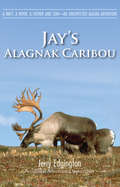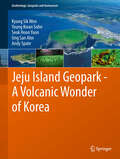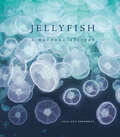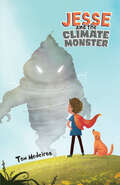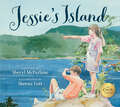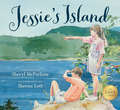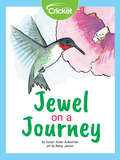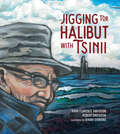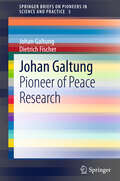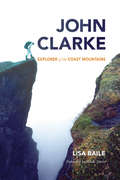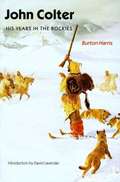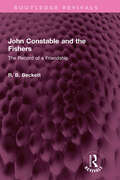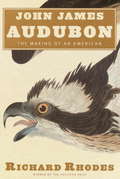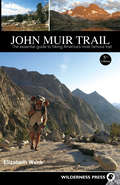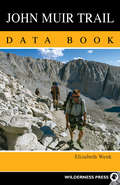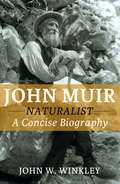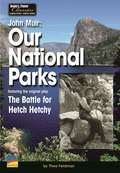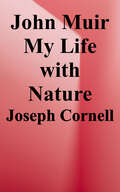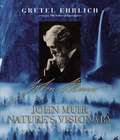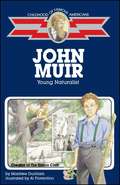- Table View
- List View
Jay's Alagnak Caribou: A Raft, A River, A Father and Son—An Unexpected Alaska Adventure
by Jerry EdgingtonJay and his dad knew things would change after summer. The seasons of boy scouts, little league, high school sports, and just hanging out, would be gone forever. But there was a chapter left to write, and it would be written on a long section of the Alagnak River in Alaska. It wouldn't be the final chapter, not by a long stretch, but it would be a transcending chapter. A self-guided moose hunt and fishing trip would be a proper way to commemorate Jay's 19th birthday. So, with fishing rods and guns, and a flight into the headwaters of the Alagnak River they embarked on their adventure. What they found was more than they imagined—much more. They found the Alaska wilderness and a freedom they didn't know existed. They found a life changing adventure—built unbreakable bonds.
Jaywalking with the Irish
by David MonaganFrom the book: For David Monagan, born in Connecticut to a staunch Irish-American family, a lifelong interest in Ireland was perhaps inescapable. David studied literature at Dublin's Trinity College in 1973 and '74, and he became captivated by the country. After enjoying many visits in the intervening years, in 2000 David and his family relocated from the U.S. to Cork, Republic of Ireland. David has written for numerous publications, including the Irish Times, Sunday Independent, and Irish Examiner, and in his wide travels has developed a keen eye for things baffling and marvelous, such as he finds everywhere around him in modern-day Ireland.
Jeju Island Geopark - A Volcanic Wonder of Korea
by Andy Spate Kyung Sik Woo Seok Hoon Yoon Ung San Ahn Young Kwan SohnThis book will deal with geological as well as cultural, historical, archaeological and biological aspects in Jeju Global Geopark. It will start with introduction of Jeju Global Geopark, geographic setting, habitats, history, economy and tourism, management, general geology and geosites, future geosites, other significant heritage sites, economically sustainable tourism, education and promotion and management plan.
Jellyfish: A Natural History
by Lisa-ann GershwinAn introduction to these bizarre and beautiful creatures of the sea, filled with color photos and illustrations: &“Fascinating.&”—Boing Boing Jellyfish are the oldest multi-organed life form on the planet, having inhabited the ocean for more than five hundred million years. With their undulating umbrella-shaped bells and sprawling tentacles, they are compelling and gorgeous, strange and dangerous. In many places they&’re also vastly increasing in number, and these population blooms may be an ominous indicator of the rising temperatures and toxicity of the oceans.Jellyfish presents these aquarium favorites in all their glory. Fifty unique species, from the purple people eater to black sea nettles, are presented in stunning photos along with the most current scientific information on their anatomy, history, distribution, position in the water, and environmental status. Foremost jellyfish expert Lisa-ann Gershwin provides an insightful look at the natural history and biology of each of these spellbinding creatures, plus a timely take on their place in the rapidly changing and deteriorating condition of the oceans. Learn about immortal jellyfish who live and die and live again—as well as those who camouflage themselves amid sea grasses and shells, hiding in plain sight. Discover the jellyfish that&’s the world&’s most venomous animal, and the jellyfish that helped scientists win the Nobel Prize. They&’re all here and more in this delightful volume. &“A thorough coverage of jellyfish history, biology and ecology. Gershwin, a marine biologist who has discovered over 200 new species of jellyfish, does an excellent job of combining a compelling narrative of 50 different jellyfish with luscious, I-can&’t-believe-they&’re-real photos.&”—Boing Boing
Jesse and the Climate Monster
by Tom MedeirosJesse and the Climate MonsterAn Introduction for parents and teachersAs the news of climate change and climate related disasters expands, our school age children are not immune to the feelings of fear and helplessness. Jesse and the Climate Monster, published as a bilingual (English/Spanish) book, allows young readers, their classmates and their families, an opportunity to begin to understand climate change as presented in an engaging tale. Within the story, early readers are exposed to many of the effects of climate change as Jesse relates the experiences of Jesse&’s classmates. In addition to the story, the accompanying links, activities, and illustrated glossary allow younger students, their classmates and their families, further access to climate information in an age-appropriate format. This story provides a ray of optimism, and a feeling of empowerment to our young readers. Jesse y el Monstruo ClimáticoUna introducción para padres y maestrosMientras que se difunden noticias de desastres relacionados con el clima, nuestros estudiantes jóvenes no son inmunes a sentimientos de miedo y desamparo. Jesse y el monstruo climático les brinda a los lectores jóvenes una oportunidad para empezar a entender el cambio climático a través de un cuento cautivador. Dentro del cuento, los lectores son expuestos a muchos de los efectos del cambio climático mientras Jesse relata las experiencias de sus compañeros de clase. Su uso de poderes recién descubiertos revela las múltiples posibles maneras de abordar el cambio climático. Además del cuento, los enlaces, actividades y glosario ilustrado les permiten a los estudiantes jóvenes profundizar su acceso a información climática en un formato apropiado para su edad. El cuento brinda un rayo de optimismo, citando evidencias de actividades respetuosas con el clima que todos pueden realizar.
Jessie's Island
by Sheryl McFarlane Sheena LottAs Jessie looks out over her island home, she sees a world of endless variety, from killer whales in the strait and bald eagles soaring overhead to anemones and tiny hermit crabs on the shore. She thinks of countless days spent exploring, fishing, swimming and canoeing. Told with lyric simplicity, this story is more than a celebration of West Coast life; it is also a reminder of the joy of childhood and the thrill of discovery. In a time when our children's entertainment has become increasingly formal and high-tech, Jessie's Island reminds us of the joy of unstructured play and the pleasures to be found in the natural world around us.
Jessie's Island
by Sheryl McFarlaneWith a long list of activities and events to attend, cousin Thomas paints a picture of city life that makes Jessie’s world seem a little dull in comparison. When her mother suggests they invite Thomas to visit their island, Jessie wonders glumly what she could possibly write in her letter that would sound as exciting as zoos, planetariums or video arcades. But as Jessie looks out over her island home, she sees a world of endless variety, from killer whales in the strait and bald eagles soaring overhead to anemones in tide pools and tiny hermit crabs on the shore. She thinks of countless days spent exploring, fishing, swimming and canoeing.
Jewel on a Journey
by Betsy James Susan Yoder AckermanTrey and Susannah hear a loud thump and learn that the fallen tiny bird laying on their deck is a Hummingbird! Miss Nora, their neighbor, cares for birds and may be able to help them save the bird. Discover what Miss Nora does to help the Hummingbird. Will the injured bird fly again?
Jewels of the Plains: Wildflowers of the Great Plains Grasslands and Hills
by Claude A. BarrFrom Abronia to Zinnia, Jewels of the Plains describes the natural history and garden merits of more than five hundred Great Plains wildflowers. Considered the authoritative guide by native plant enthusiasts and horticulturists, it captures the unique beauty, resilience, and variety of wildflowers in the Great Plains.Claude A. Barr did not set out to be a writer. In 1910, he homesteaded 160 acres of prairie in the southwest corner of South Dakota, intending to become a farmer. Despite challenging conditions, Barr fell in love with the land and its native flora. He began contributing profiles of plains wildflowers to gardening magazines, which precipitated requests for seed and led him to start a mail-order nursery, Prairie Gem Ranch. What began as a Depression-era sideline eventually gained a worldwide clientele, and Barr became a respected ambassador for the wildflowers of this part of the American landscape.Decades of observing plants in the wild and growing them for his nursery, as well as careful study of scientific sources, gave Barr unequaled knowledge that culminated in this acclaimed book. Wonderfully written and deeply researched, Jewels of the Plains is more than a field guide or how-to manual. It&’s a pioneering text on native plant horticulture that details plant life on the prairie in the voice of one with intimate familiarity with the subject. Each description reads like a mini nature essay, giving insight into both the plants and Barr&’s engaging personality.Edited to incorporate new scientific information, this edition includes an Introduction and supplemental notes by botanist and horticulturalist James H. Locklear. He places Barr&’s remarkable life and work in historic and scientific context, illuminating his accomplishments from a fresh perspective.
Jigging for Halibut With Tsinii (Sk'ad'a Stories Series #1)
by Robert Davidson Sara Florence DavidsonBased on Haida artist Robert Davidson's own experiences with Tsinii (his grandfather), this tender story highlights intergenerational knowledge and authentic learning experiences.Off the northern tip of Haida Gwaii, a boy goes fishing with Tsinii, his grandfather. As they watch the weather, jig for halibut, and row with the tides, the boy realizes there&’s more to learn from Tsinii than how to catch a fish.Written by the creators of Potlatch as Pedagogy, this book brings the Sk'ad'a Principles to life through the art of Janine Gibbons.
Jigging for Halibut With Tsinii (Sk'ad'a Stories Series #1)
by Robert Davidson Sara Florence DavidsonBased on Haida artist Robert Davidson's own experiences with Tsinii (his grandfather), this tender story highlights intergenerational knowledge and authentic learning experiences.Off the northern tip of Haida Gwaii, a boy goes fishing with Tsinii, his grandfather. As they watch the weather, jig for halibut, and row with the tides, the boy realizes there&’s more to learn from Tsinii than how to catch a fish.Written by the creators of Potlatch as Pedagogy, this book brings the Sk'ad'a Principles to life through the art of Janine Gibbons.
Johan Galtung
by Dietrich Fischer Johan GaltungThis is the first ever anthology of key articles by Johan Galtung, widely regarded as the founder of the academic discipline of peace studies. It covers such concepts as direct, structural and cultural violence; theories of conflict, development, civilization and peace; peaceful conflict transformation; peace education; mediation; reconciliation; a life-sustaining economy; macro-history; deep culture and deep structure; and social science methodology. Galtung has contributed original research, concepts and theories to more than 20 social science disciplines, including sociology, international relations and future studies, and has also applied his new insights in practice. The book is a valuable resource for researchers and practitioners, and can serve as a supplemental textbook for graduate and upper undergraduate courses in peace studies and related fields.
John Clarke
by Lisa BaileClarke had no interest in "trophy climbs" and never did ascend many of BC's highest peaks. On the other hand, he explored more virgin territory and racked up more first ascents than any other climber-perhaps more than any climber who ever lived.Although he came to be honoured far and wide and is one of the few mountaineers to be awarded the Order of Canada, he was a modest man who pursued his passion without fanfare, frequently embarking on gruelling expeditions into unknown territory by himself. His reputation spread and grew to legendary proportions, not just owing to the prodigious scale of his achievements, but because of the way he carried them out-he travelled light and scorned technology, wearing cotton long johns and eating homemade granola.He dedicated his life to exploring the numberless, nameless peaks of the Coast Range and worked at odd jobs just long enough to pay for the next season's climbing. He was charismatic and famously attractive to women, but none were able to compete with his first love and he didn't marry until he was almost fifty. Always a popular lecturer, in his later years he devoted his considerable energies to the cause of environmental education. After he succumbed to cancer in 2003, the BC government named Mount John Clarke in his honour-fitting recognition for the man who had himself named many BC mountains.John Clarke: Explorer of the Coast Mountains covers this remarkable life from beginning to end, examining Clarke through his own words and pictures as well as through the words of his many friends. All agree it was an honour to have known him, and readers will find it equally inspiring to meet him through these pages.
John Colter: His Years in the Rockies
by Burton Harris David G. LavenderJohn Colter was a crack hunter with the Lewis and Clark expedition before striking out on his own as a mountain man and fur trader. A solitary journey in the winter of 1807-8 took him into present-day Wyoming. To unbelieving trappers he later reported sights that inspired the name of Colter's Hell. It was a sulfurous place of hidden fires, smoking pits, and shooting water. And it was real. John Colter is known to history as probably the first white man to discover the region that now includes Yellowstone National Park. In a classic book, first published in 1952, Burton Harris weighs the facts and legends about a man who was dogged by misfortune and "robbed of the just rewards he had earned. " This Bison Book edition includes a 1977 addendum by the author and a new introduction by David Lavender, who considers Colter's remarkable winter journey in the light of current scholarship.
John Constable and the Fishers: The Record of a Friendship (Routledge Revivals)
by R B BeckettFirst published in 1952, John Constable and the Fishers is based on original letters which have never been published in full before. These have been woven into a connected narrative dealing with the friendship which existed between Constable and various members of the Fisher family, more particularly the Bishop of Salisbury (a personal friend of George III who entrusted him with the education of Princess Charlotte as heiress to the throne) and his nephew the Archdeacon of Berkshire. The Archdeacon’s letters give a picture of life in a cathedral closed and country vicarages, reminiscent of Trollope’s Barchester and Thomas Hardy’s Wessex. In return Constable confides his ideals and ambitions; and as Mr. Grigson suggests in his introduction, the encouragement he received from the Fishers may have had a decisive effect on the future of landscape art. The letters are fully annotated and are illustrated with connected works done by Constable. This book will of interest to students of history, art and literature.
John James Audubon: The Making of an American
by Richard RhodesAn award-winning author who has frequently explored science and American history offers the first major new biography in many years of ornithologist/artist John James Audubon (1785-1851). Rhodes traces Audubon's arrival in America from France, his (for a time) commuter marriage, and career culminating in his magnum opus The Birds of America. He presents a well-rounded portrait of the Audubon Society's namesake and the U. S. of the early frontier period. Illustrations include color plates of Audubon's celebrated watercolors of North American birds. Annotation ©2004 Book News, Inc. , Portland, OR (booknews. com)
John Muir
by Margaret Goff ClarkA biography of the nineteenth-century naturalist, explorer, and writer who was influential in establishing our national park system.
John Muir
by Thomas LockerLaced with richly painted landscapes, this book brings readers the world and words of John Muir. This is the second book in a series of illustrated books by Thomas Locker that introduces readers to notable people who loved and wrote about the American land, especially about the value of wilderness.
John Muir Trail
by Elizabeth WenkLizzy Wenk's authoritative guide John Muir Trail describes the 212-mile trail, running from Yosemite Valley to the summit of Mt. Whitney. It provides all necessary planning information, including up-to-date details on wilderness and permit regulations, food resupplies, trailhead amenities, and travel from nearby cities. Useful essentials are updated GPS coordinates and maps for prominent campsites (along with an updated list of sites along the trail), trail junctions, bear boxes, and other points of interest. The trail descriptions also include natural and human history to provide a workout for both body and mind -- a must-have for any Muir Trail enthusiast. Note that the text includes the southbound trail description, while the full guide with the northbound description is available as a separate ebook product.
John Muir Trail Data Book
by Elizabeth WenkA derivative of the comprehensive John Muir Trail by Sierra expert Elizabeth Wenk, this data book is perfect for the weight-conscious hiker. A brief introductory section provides planning data, including information on permits, trailhead transport, and food resupplies. This is followed by on-the-trail information, including custom-made topo maps, elevation profiles, data tables, and labeled panoramas from prominent passes. There are tables for trail junctions, nearly 300 campsites, ranger stations, food-storage lockers, and lateral trails accessing the JMT. For detailed information on planning for your trip, considerations for hiking in the Sierra Nevada, or a trail description, those are only available in the comprehensive John Muir Trail book.
John Muir: A Concise Biography of the Great Naturalist
by John W. WinkleyJohn Muir, Naturalist, first published in 1959, is an account of the life of John Muir (1838-1914) an early advocate of nature preservation. From his childhood in Scotland and the family’s move to Wisconsin, the book describes Muir’s early influences and his love of nature. After a time at the University of Wisconsin-Madison, and working in Indiana, Muir set off—on foot—to the Gulf of Mexico, and eventually ended in California, devoting time to the preservation of Yosemite and the western forests. In later life, Muir operated a large fruit farm in Martinez, California, while writing 12 books and over 300 articles, and co-founding the conservation organization the Sierra Club. Included are 6 pages of illustrations.
John Muir: Featuring the Original Play, The Battle for Hetch Hetchy (Readers Theater Classics)
by Thea FeldmanNIMAC-sourced textbook
John Muir: My Life With Nature (A Sharing Nature With Children Book)
by Joseph CornellA biography of the man known as "father of America's national parks" and an influential conservationist, told in the first person, using Muir's own words.
John Muir: Nature's Visionary
by Gretel EhrlichIn this definitive photobiography, Ehrlich brings her award-winning grace and insight to the life of one of our nation's most prized environmental heroes--John Muir, a founder of the Sierra Club.
John Muir: Young Naturalist (Childhood of Famous Americans Series)
by Montrew DunhamA founding father of the conservation movement in the United States, John Muir was born in Scotland and emigrated to Wisconsin when he was eleven. This easy-to-read fictionalized biography takes a look at Muir's life as young naturalist, destined to become one of America's first eco-heroes.
